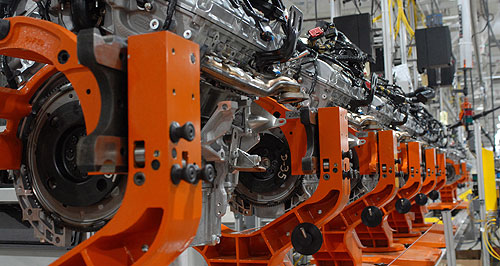Make / Model Search
News - FordFord aims for greener ChinaPowerhouse: Frugal yet powerful Ford EcoBoost engines and six-speed automatic transmissions will be built in China to satisfy local demand and reduce CO2 emissions. 20 new high-tech engines by 2015 as Ford targets lower emissions in China1 Dec 2011 FORD has announced plans to improve its green credentials in China with the introduction of 20 new engines by 2015, including high-tech EcoBoost turbo and direct-injection naturally aspirated units, many of which will be produced in new factories on Chinese soil. As part of the major upgrade, claimed to provide the Chinese Ford fleet with a 20 per cent reduction in fuel consumption and CO2 emissions, the Detroit giant also confirmed it will manufacture its three-cylinder 1.0-litre EcoBoost engine in China. Further improving efficiency while aiding drivability, existing four-speed automatic transmissions will also be replaced by six-speed units, which depending on application will be traditional torque-converter style or Ford’s PowerShift dual-clutch auto. Supporting the move, Ford’s Chinese joint venture, Changan Ford Mazda Automobile (CFMA), is already building new engine and transmission plants – representing an investment of $US850 million – both of which have a starting production capacity of 400,000 units a year. Ford Asia Pacific and Africa vice-president for product development Kumar Galhotra said the new engines will power the planned 15 new models – announced at April’s Shanghai motor show – that will spearhead the Blue Oval push into what is now the world’s largest car market.  He said the company is “committed to be a fuel economy leader in every segment that we compete in by utilising advanced powertrain technologies (that) represent a core part of our near-term sustainability goals in China”. He said the company is “committed to be a fuel economy leader in every segment that we compete in by utilising advanced powertrain technologies (that) represent a core part of our near-term sustainability goals in China”.EcoBoost engines combine turbocharging, direct fuel injection and precise valve timing to provide power outputs equivalent to much larger naturally-aspirated engines without the size, weight or fuel consumption penalty. They have already begun a global rollout in Ford-branded products. Ford plans to produce 1.5 million EcoBoost engines annually by 2013, by which time it expects almost 80 per cent of its global product line-up to be available with the technology, with most Ford-branded passenger cars in China expected to offer it by 2015. Although Ford entered the Chinese market relatively late, it expects up to 70 per cent of its planned global sales growth from 5.3 million units in 2010 to eight million in 2015 will come from the Asia Pacific region, with China acting as a major cornerstone. As in Australia, the first EcoBoost-powered Ford model in China was the Mondeo, which employs a 2.0-litre four-cylinder engine producing a 149kW of power and 300Nm of torque while consuming around eight litres of fuel per 100 kilometres. Ford continues to sell its engines to former Premier Automotive Group brands like Volvo and Jaguar Land Rover, which were among the first to offer EcoBoost-powered cars in Australia. Mondeo was the first Ford-branded EcoBoost cab off the rank here in June this year and will be followed soon by the Falcon, which will debut a rear-drive application for the turbocharged 2.0-litre four-cylinder. EcoBoost V6 engines offering V8-like performance are available in North America, where they have usurped bent-eight powertrains as the top-seller in Ford’s F150 pick-up and provide considerable performance for the all-wheel-drive Taurus sedan that could one day replace the Falcon here. At the other end of the spectrum, Ford’s first three-cylinder engine – which produces similar power and torque to a 1.6-litre naturally aspirated four-cylinder – will find its way under the bonnet of the Focus small car, although its application in Australia is not yet confirmed. Until recently it would have been unthinkable for a car in this segment to be powered by a 1.0-litre engine, but recent advancements in technology now make such downsizing possible. Production of the 1.0-litre EcoBoost engine recently began at Ford’s Cologne engine plant in Germany, where 350,000 units will be built annually. A new plant in Romania will be completed early next year, doubling European production capacity for the tiny triple. Ford also applies some of the EcoBoost technologies to naturally aspirated engines, exemplified by the 2.0-litre GDi (gasoline direct-injection) unit that made its Australian debut on the new Focus.  Read more10th of November 2011  Focus to get Ford’s new three-pot turboFord Oz not yet committed to 1.0-litre EcoBoost despite 2012 debut in Euro Focus27th of September 2011  Ford invests more in ChinaImportance of Asia-Pacific underscored by Ford’s latest Chinese investment |
Click to shareFord articlesResearch Ford Motor industry news |











Facebook Twitter Instagram